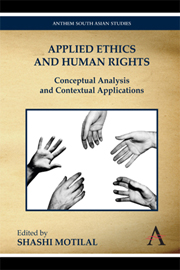Book contents
- Frontmatter
- Contents
- Preface
- Introduction
- Part One Rights, Obligations and Responsibilities
- Part Two Human Rights Issues
- 10 Fragile Identities and Constructed Rights
- 11 Affirmative Action: Compensation or Discrimination?
- 12 Ethics, Human Rights and the LGBT Discourse in India
- 13 Distributive Justice: Locating in Context
- 14 Punishment and Human Rights
- 15 Rights of the ‘Mad’ in Mental Health Sciences
- 16 Choice, Life and the (m)Other: Towards Ethics in/of Abortion
- 17 The Nationalist Project and the Women's Question: A Reading of The Home and the World and Nationalism
- 18 On the Idea of Obligation to Future Generations
- 19 Morality in Cyberspace: Intellectual Property and the Right to Information
- 20 Violence – A Right to the Survival of the Self?
- 21 ‘Moral Obligation’ to Fight for the Prevention of Greater Calamity: A Debate between Sādharana Dharma and Sva Dharma
- 22 Globalisation and Human Rights
- Notes on Contributors
12 - Ethics, Human Rights and the LGBT Discourse in India
from Part Two - Human Rights Issues
Published online by Cambridge University Press: 05 March 2012
- Frontmatter
- Contents
- Preface
- Introduction
- Part One Rights, Obligations and Responsibilities
- Part Two Human Rights Issues
- 10 Fragile Identities and Constructed Rights
- 11 Affirmative Action: Compensation or Discrimination?
- 12 Ethics, Human Rights and the LGBT Discourse in India
- 13 Distributive Justice: Locating in Context
- 14 Punishment and Human Rights
- 15 Rights of the ‘Mad’ in Mental Health Sciences
- 16 Choice, Life and the (m)Other: Towards Ethics in/of Abortion
- 17 The Nationalist Project and the Women's Question: A Reading of The Home and the World and Nationalism
- 18 On the Idea of Obligation to Future Generations
- 19 Morality in Cyberspace: Intellectual Property and the Right to Information
- 20 Violence – A Right to the Survival of the Self?
- 21 ‘Moral Obligation’ to Fight for the Prevention of Greater Calamity: A Debate between Sādharana Dharma and Sva Dharma
- 22 Globalisation and Human Rights
- Notes on Contributors
Summary
Introduction
To be sure, sexuality is still not seen as a serious area for academic enquiry in India. The two constituencies that have taken sexuality up as a complex for research and action have been the women's movement and Women's Studies and the same-sex rights movement in India (more popularly known as the LGBT (lesbian, gay, bisexual and transgender) and, increasingly, as the ‘queer’ movement, another indication of how globalisation matters given the currency of this term in contexts like India despite its provenance in US academia). Both these constituencies – feminists and LGBT folk – are themselves fledgling and marginal to mainstream political and academic life in India, the two arenas in which they seek to make interventions. Consequently, their claim that sexuality needs to be focused on is also fledgling and marginal.
Both movements have used the academic and the cultural as important vehicles in the articulation of their positions and these positions have been built as much on the streets as in theoretical and academic knowledge production. Further, this articulation has borrowed heavily from the available languages of feminism and sexuality-based movements in the West (by which I mean Western Europe and North America), as the presence of both movements in the West preceded their formal formation as movements in the Third world. Both the women's movement and the LGBT one from their inception here have been accused of being imports from the West, inauthentic and inorganic to the Indian contexts.
- Type
- Chapter
- Information
- Applied Ethics and Human RightsConceptual Analysis and Contextual Applications, pp. 151 - 170Publisher: Anthem PressPrint publication year: 2010



